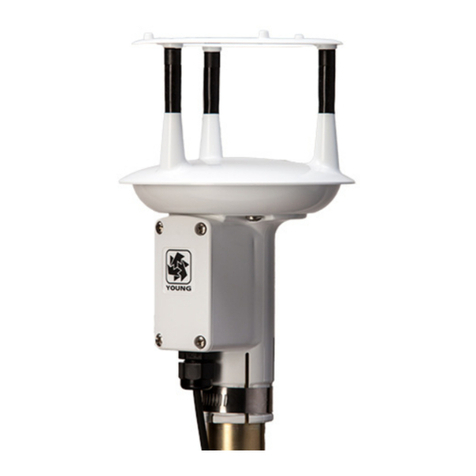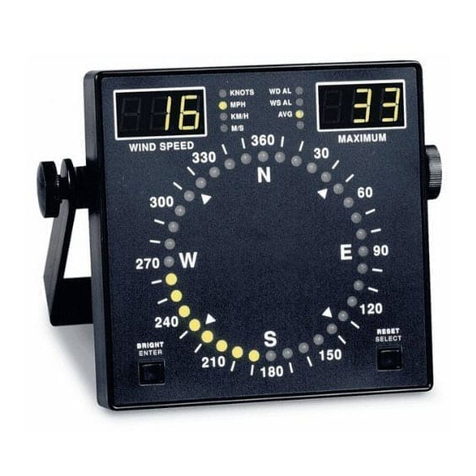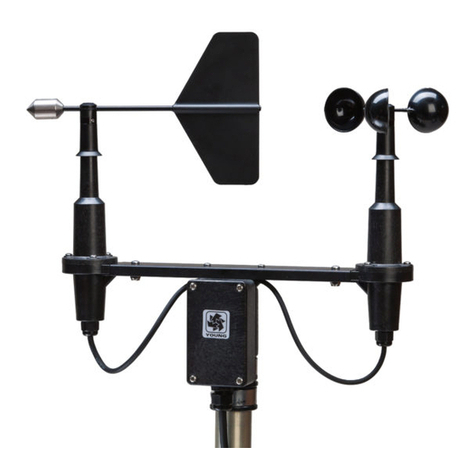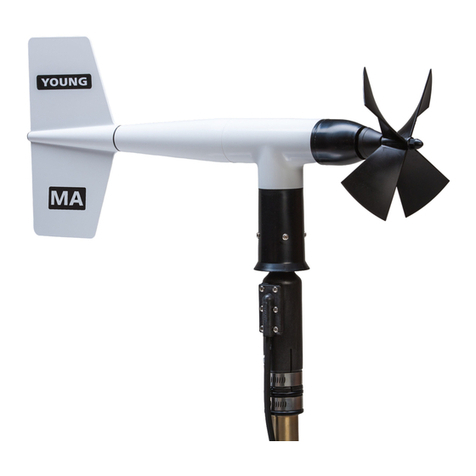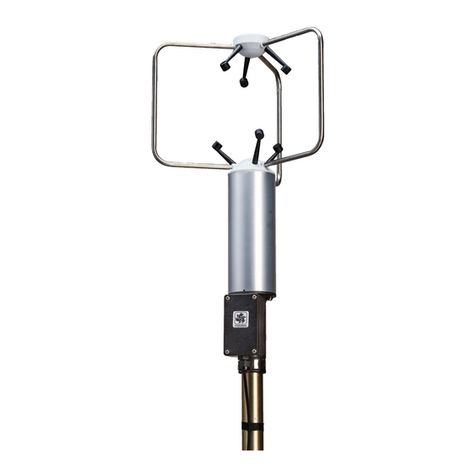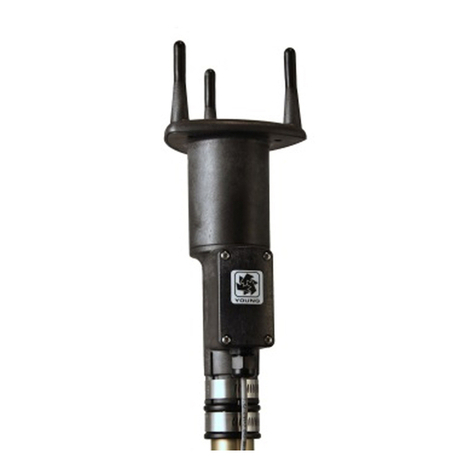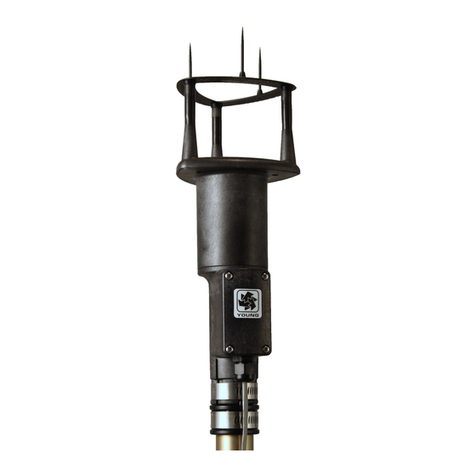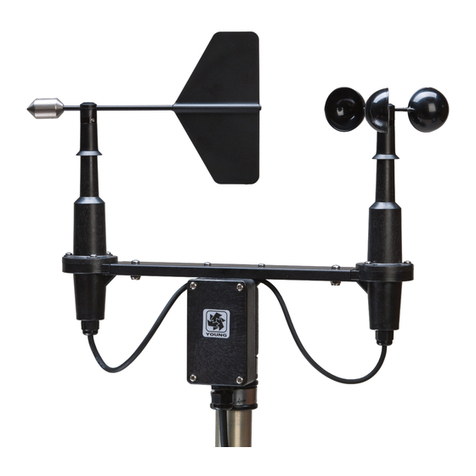
Page 1
32400-90(R)
MODEL 32400
SERIAL INTERFACE
SERIAL INTERFACE SPECIFICATION SUMMARY*
Wind Speed Input:
Sensor Type: AC Frequency Generator
Sensitivity: 50mV p-p at 10Hz
Range: 0-2000 Hz
Wind Direction Input:
Sensor Type: Potentiometer
Range: 0-5000mV = 0 to 355 degrees
Excitation: 5000mV (limited to 5 mA)
Voltage Inputs (Auxiliary Sensor Inputs):
Resolution: 12-bit
VIN1 and VIN2 0-1000mV
VIN3 and VIN4 0-5000mV
Voltage Outputs:
OUT1 0-5000mV 0-100 m/s wind speed
OUT2 0-5000mV 0-360° wind direction
Serial Output: Full duplex RS-232,
Half duplex RS-485 (2 mS turnaround),
Baud: 1200, 4800, 9600, 19.2K, &
38.4K, 8 data, 1 stop, no parity
Operating Temp: -50°C to 50°C
Power: 11 to 30 VDC, 40 mA
Mounting: Stainless steel U-bolt mounting clamp
ts vertical pipe 25-50 mm (Ø1-2 in)
(1 inch IPS (Ø1.34 inch actual)
Size: 7.50” (19.0cm) H
3.00” (7.6cm) W
3.00” (7.6cm) D
*Specications subject to change
1.0 INTRODUCTION
The Model 32400 SERIAL INTERFACE measures wind speed and
direction signals from YOUNG sensors and signals from four general
purpose voltage inputs. The voltage inputs may be used with YOUNG
temperature, humidity, barometric pressure, precipitation, or other
sensors. One of the voltage inputs may also be used with a tipping
bucket precipitation gauge. These input signals are converted into
scaled values and placed in a serial string, which is output at up to
15 hertz.
The serial output is available in several serial data formats in either full
duplex RS-232 or half-duplex RS-485 signals. Both continuous and
polled serial outputs are available. When polled, up to 16 units can
be networked together. For marine applications the 32400 produces
standard NMEA serial output sentences. Calibrated voltage outputs
for wind speed and direction are also provided when the 32400 is
connected to a YOUNG wind sensor.
2.0 INSTALLATION
The 32400 is supplied in a weather-resistant enclosure that mounts
with a stainless steel U-bolt that will t a 25 to 50 mm (1-2 in.) diameter
vertical pipe. Refer to the WIRING DIAGRAM for electrical connection
details and jumper settings.
3.0 OPERATION
Operation begins automatically when power is applied. Jumper
settings congure the 32400 for common output formats as well as
output type. Input signal connections are dependent upon the serial
output format.
3.1 JUMPER CONFIGURATIONS
W1 JUMPERS A, B, and C, determine serial output format. Jumper
configurations and associated output format are listed below:
1 signies that jumper is installed, 0 signies that jumper is omitted.
See the SERIAL FORMAT DIAGRAM for more details.
A B C SERIAL OUTPUT FORMAT (Baud Rate, Output Rate)
0 0 0 ASCII Ouput (9600, 2Hz)
001Polled ASCII (9600)
0 1 0 NMEA1 (4800, 2 Hz)
0 1 1 NMEA2 (4800, 2 Hz)
1 0 0 RMYT (9600, 15 Hz)
1 0 1 PRECIP (9600, 15 Hz)
1 1 0 PRECIP POLLED (9600)
1 1 1 SOFTWARE Mode (set by user, see section 4.2)
ASCII and POLLED ASCII are general purpose outputs that may
be used with the YOUNG 26800 or devices that can communicate
serially.
NMEA1 and NMEA2 outputs are generally for marine applications.
NMEA1 produces a “$WIMVW” string containing speed and direction
values.NMEA2 produces both a “$WIMVW” and “$WIXDR” string,
the latter containing temperature, humidity and pressure values.
RMYT is a binary format for use with the YOUNG Wind Tracker.
PRECIP and PRECIP POLLED congure VIN4 as a special input to
count tipping bucket precipitation gauge switch closures. (Requires
a 10K ohm resistor from VIN4 to EXC terminal.)
SOFTWARE mode allows output format and other parameters to
be set using serial commands. Please see section 4.0 SERIAL
COMMUNICATION and the SERIAL FORMAT DIAGRAM for more
information.
W2 & W3 JUMPERS determine output connection type. Only one
connection type may be used at a time. Please refer to the WIRING
DIAGRAM for jumper location and connection details.
JUMPERS OUTPUT TYPE
VOUT
Calibrated output for wind speed and direction
OUT1 0-5000mV = 0-100 m/s Wind Speed
OUT2 0-5000mV = 0-360 degrees Wind Direction
232 RS-232 full duplex serial
485 RS-485 half duplex serial
3.2 SIGNAL INPUTS
The 32400 has two special inputs for wind speed and direction from
YOUNG wind sensors and four voltage input channels for connection
to temperature, humidity, barometric pressure, precipitation, or other
sensors. For best performance, sensors should be installed within
3m (10ft.) of the 32400.
Measurements from the voltage input channels are converted to
numerical values (0-4000) when ASCII, POLLED ASCII, PRECIP,
or PRECIP POLLED are used. VIN1 and VIN2 full scale input is
1000mV DC (serial value = input mV x 4); VIN3 and VIN4 full scale
input is 5000mV (serial value = input mV x 0.8). Note that VIN4 is
used to count tipping bucket precipitation sensor tips when PRECIP
or PRECIP POLLED are used.
When NMEA1 or NMEA2 are used the measurements from the
voltage input channels are converted to following:
VIN1 (0 to 1000mV must = -50 to +50 C),Temperature (C);
VIN2 (0 to 1000mV must = 0 to 100%), Humidity (%);
VIN3, Barometric Pressure (hPa);
VIN4, not used. [Wind speed, (Knots)]
Please refer to SERIAL FORMAT DIAGRAM and WIRING DIAGRAM
in the back of this manual for additional details.
